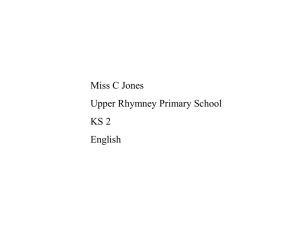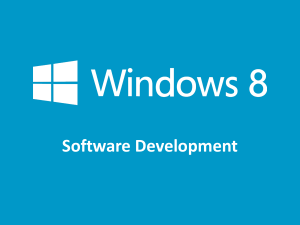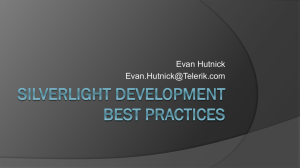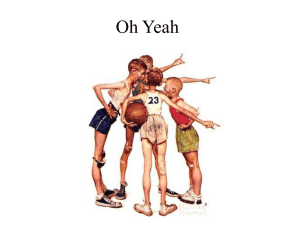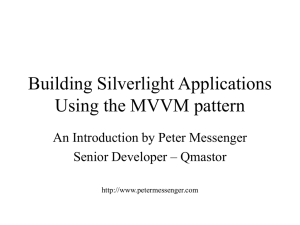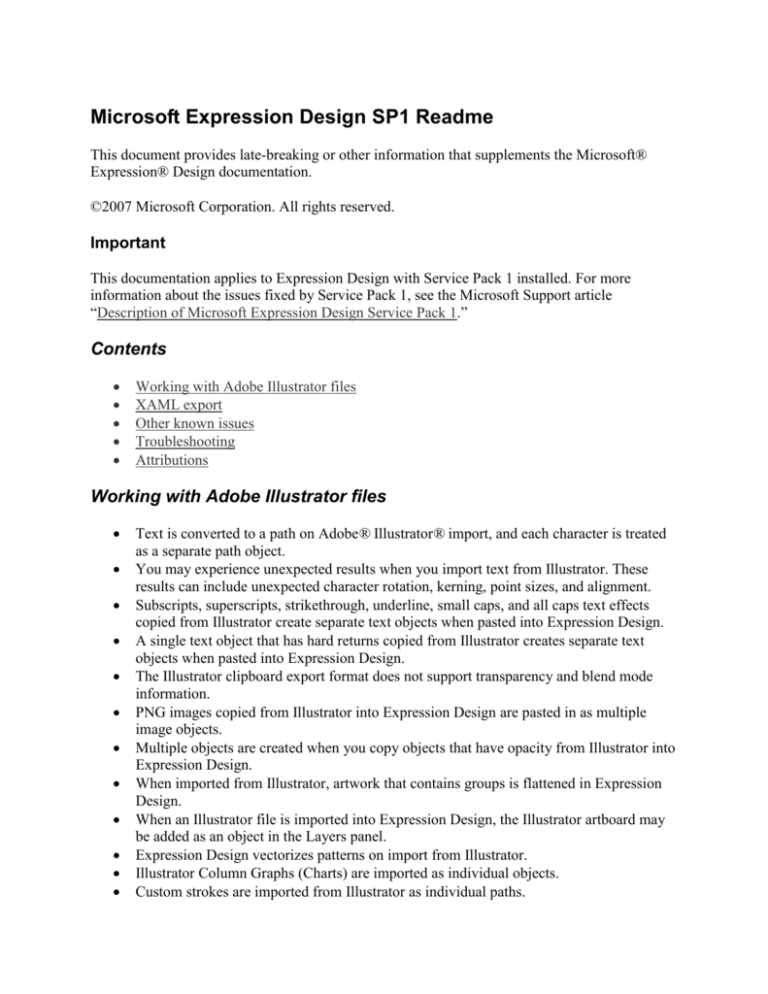
Microsoft Expression Design SP1 Readme
This document provides late-breaking or other information that supplements the Microsoft®
Expression® Design documentation.
©2007 Microsoft Corporation. All rights reserved.
Important
This documentation applies to Expression Design with Service Pack 1 installed. For more
information about the issues fixed by Service Pack 1, see the Microsoft Support article
“Description of Microsoft Expression Design Service Pack 1.”
Contents
Working with Adobe Illustrator files
XAML export
Other known issues
Troubleshooting
Attributions
Working with Adobe Illustrator files
Text is converted to a path on Adobe® Illustrator® import, and each character is treated
as a separate path object.
You may experience unexpected results when you import text from Illustrator. These
results can include unexpected character rotation, kerning, point sizes, and alignment.
Subscripts, superscripts, strikethrough, underline, small caps, and all caps text effects
copied from Illustrator create separate text objects when pasted into Expression Design.
A single text object that has hard returns copied from Illustrator creates separate text
objects when pasted into Expression Design.
The Illustrator clipboard export format does not support transparency and blend mode
information.
PNG images copied from Illustrator into Expression Design are pasted in as multiple
image objects.
Multiple objects are created when you copy objects that have opacity from Illustrator into
Expression Design.
When imported from Illustrator, artwork that contains groups is flattened in Expression
Design.
When an Illustrator file is imported into Expression Design, the Illustrator artboard may
be added as an object in the Layers panel.
Expression Design vectorizes patterns on import from Illustrator.
Illustrator Column Graphs (Charts) are imported as individual objects.
Custom strokes are imported from Illustrator as individual paths.
Strokes and fills on the same object may be separated when you import the object from
Illustrator.
Mesh gradients from Illustrator may take a long time to import. Expression Design
vectorizes gradient meshes, creating many small shapes that take a long time to render.
Expression Design does not support the following blend modes, and maps them onto the
Normal blend mode:
o Overlay
o HardLight
o SoftLight
o Exclusion
o Hue
o Saturation
o Color
o Luminosity
Expression Design does not support Illustrator knockout groups.
XAML export
Blend modes are ignored on export. Blend modes are not support by XAML.
When text is exported as editable textblocks, text that is attached to a path is not
exported.
On rectangles that use a basic stroke, the dash property value is ignored.
The object registration point is not exported.
A rectangle is written out as a path (not as a rectangle) if any transform such as Rotate or
Skew is applied in Expression Design.
We recommend that you do not use very detailed vector strokes as doing so may produce
large XAML files.
The Vectorize image strokes option does not work on strokes created from JPEGs or
from photos in the stroke gallery.
The setting of levels for the Vectorize image stroke option does not affect the exported
or copied and pasted XAML.
Objects that use a live effect cannot be copied and pasted in Expression Blend™; use
Export instead.
Copying XAML and pasting it into the Expression Blend XAML code editor may clip
some parts of the text. You can remove the Width and Height properties to make sure
the text will be sized automatically. Standard copy and paste does not exhibit this
problem.
XAML does not support all the text properties. Some text formatting may be lost in
converting the following properties:
o Leading
o Tracking
o Horizontal scale
o Baseline offset
The following additional text properties are not supported in XAML for Silverlight:
o Font family (except for fonts that Silverlight supports: Arial, Arial Black, Comic
Sans MS, Courier New, Georgia, Lucida Grande/Lucida Sans Unicode, Times
New Roman, and Trebuchet MS)
o Alignment
o Subscript, superscript
We recommend that you select the Rasterize all live effects option, for the following
reasons:
Windows Presentation Foundation (WPF) supports Drop shadow, Gaussian blur, and
Outer glow bitmap effects, but we do not recommended them for frequent use because
they significantly decrease performance.
Live effects not supported by WPF will not appear in the exported XAML unless you
select this option.
Silverlight does not support bitmap effects. If this option is not selected, the effects will
not appear in the exported XAML.
Far Eastern text shows up correctly in Expression Design and Expression Blend but,
because it is not supported in Silverlight, it appears as blocks in the browser.
We do not recommend that you use Image fills for Silverlight because they will not be
visible and may cause Expression Blend projects to crash.
Using a gradient fill on text causes an error in Silverlight. This is caused if you use
carriage returns and tabs in the <run> tag in the exported XAML. Remove the carriage
returns and tabs between <run> and </run> to fix this problem.
The XAML property StrokeThickness will be set to 1 for objects whose stroke width is
set to 0 in Design.
Using both a gradient fill and gradient stroke on an object may not align correctly on
export.
Stroke color on text that is exported as editable textblocks is ignored on export. XAML
supports only one text color.
Live effects are not applied to a warp group when exporting to XAML for Silverlight.
Other known issues
Text in Setup dialog boxes does not display correctly when an East Asian version of
Expression Design is installed on an operating system that doesn't match the language
version of Expression Design.
Expression Design does not support creating a stroke with a cloned object.
Troubleshooting
Problem: When you have Illustrator and Expression Design open at the same time, and you copy
from Illustrator with the CMYK color space active, the colors will not remain accurate when
pasted into Expression Design.
Solution: Convert the Illustrator (.ai) files from CMYK to RGB before the copy-and-paste
action.
Problem: Making a compound path and then adjusting the stroke width on the artboard behaves
as if the path wasn't made into a compound object, yet the Layers panel shows that it is indeed a
compound path.
Solution: Release the compound path and apply it again.
Problem: Errors are generated in Expression Blend when you add a XAML file generated in
Expression Design that has rasterized live effects or includes images.
Solution: Use the Link Existing Item command on the Project menu in Expression Blend
instead of Add Existing Item. Alternatively, you can manually add the image files into the
Expression Blend project.
Problem: When you export artwork to XAML using the Export editable TextBlocks option,
text on a path does not export as expected.
Solution: Select the Export flattened paths option instead when you export to XAML.
Problem: Vectorizing image strokes does not work correctly on image strokes that are created
from JPEG images or from photos in the Stroke Gallery.
Solution: Rasterize the image stroke instead of vectorizing it.
Attributions
© Portions copyright 2007 by Liberty Technology Systems, Inc. Portions of Liberty Technology
Systems, Inc.'s software require the following notices:
It is based in part on the work of the FreeType Team, and is also derived in part from the RSA
Data Security, Inc. MD5 Message Digest Algorithm.
Copyright © 1988-1997 Sam Leffler
Copyright © 1991-1997 Silicon Graphics, Inc.
Permission to use, copy, modify, distribute, and sell this software and its documentation for any
purpose is hereby granted without fee, provided that (i) the above copyright notices and this
permission notice appear in all copies of the software and related documentation, and (ii) the
names of Sam Leffler and Silicon Graphics may not be used in any advertising or publicity
relating to the software without the specific, prior written permission of Sam Leffler and Silicon
Graphics.
COPYRIGHT NOTICE
Copyright © 1996 by: Massachusetts Institute of Technology (MIT)
This W3C software is being provided by the copyright holders under the following license. By
obtaining, using and/or copying this specification, you agree that you have read, understood, and
will comply with the following terms and conditions:
Permission to use, copy, and distribute this specification and its documentation for any purpose
and without fee or royalty is hereby granted, provided that the full text of this NOTICE appears
on ALL copies of the specification and documentation or portions thereof, including
modifications, that you make.
Copyright © 1994-1996 SunSoft, Inc.
Rights Reserved
Permission is hereby granted, free of charge, to any person obtaining a copy of this software and
associated documentation files (the "Software"), to deal in the Software without restriction,
including without limitation the rights to use, copy, modify, merge, publish distribute,
sublicense, and/or sell copies of the Software, and to permit persons to whom the Software is
furnished to do so, subject to the following conditions:
The above copyright notice and this permission notice shall be included in all copies or
substantial portions of the Software.
Copyright © Little CMS.
Permission is hereby granted, free of charge, to any person obtaining a copy of this software and
associated documentation files (the "Software"), to deal in the Software without restriction,
including without limitation the rights to use, copy, modify, merge, publish, distribute,
sublicense, and/or sell copies of the Software, and to permit persons to whom the Software is
furnished to do so, subject to the following conditions: The above copyright notice and this
permission notice shall be included in all copies or substantial portions of the Software.
JasPer License Version 2.0
Copyright © 1999-2000 Image Power, Inc.
Copyright © 1999-2000 The University of British Columbia
Copyright © 2001-2003 Michael David Adams
All rights reserved.
Permission is hereby granted, free of charge, to any person (the "User") obtaining a copy of this
software and associated documentation files (the "Software"), to deal in the Software without
restriction, including without limitation the rights to use, copy, modify, merge, publish,
distribute, and/or sell copies of the Software, and to permit persons to whom the Software is
furnished to do so, subject to the following conditions:
The above copyright notices and this permission notice (which includes the disclaimer below)
shall be included in all copies or substantial portions of the Software.
The name of a copyright holder shall not be used to endorse or promote products derived from
the Software without specific prior written permission.

